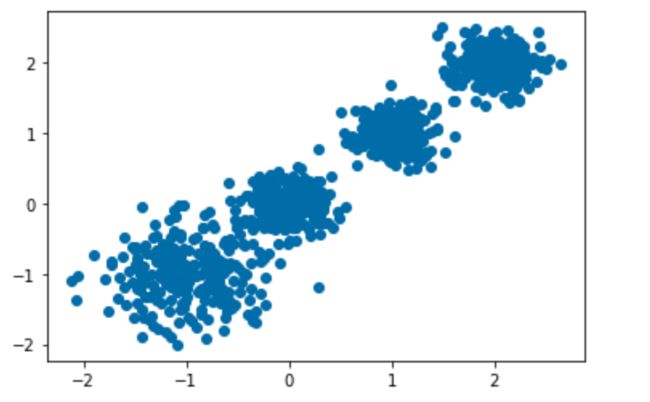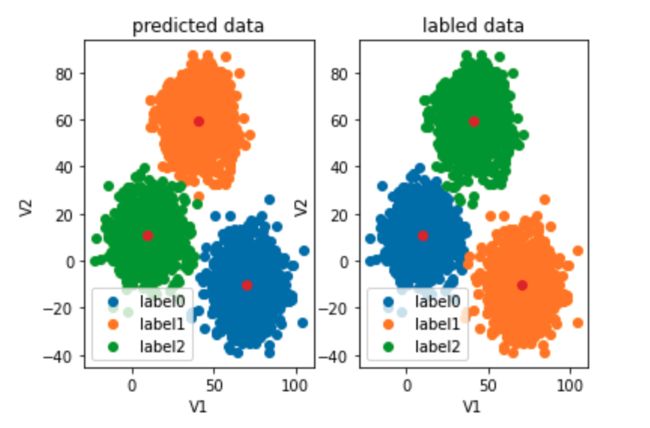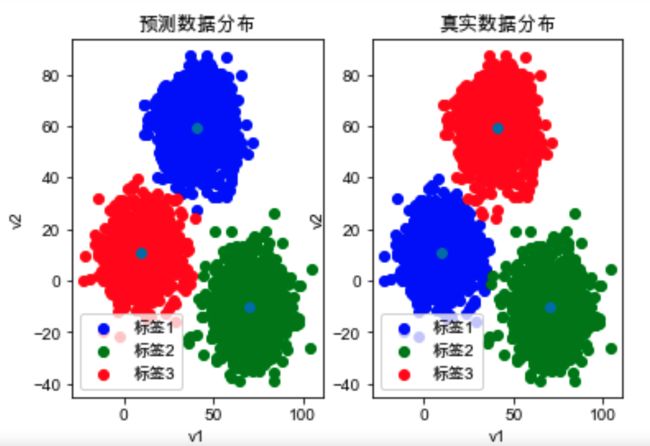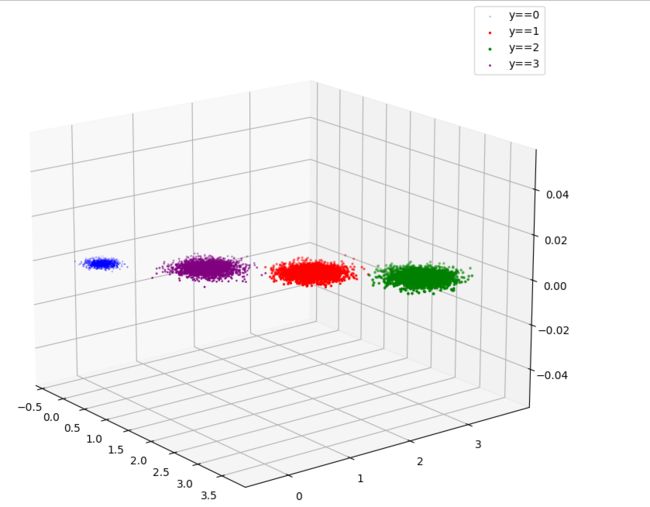机器学习----聚类
聚类
无监督学习 (unsupervised learning) 是找出输入数据的模式。比如,它可以根据电影的各种特征做聚类,用这种方法收集数据为电影推荐系统提供标签。此外无监督学习还可以降低数据的维度,它可以帮助我们更好的理解数据。
聚类算法:
一种典型的无监督学习算法,主要用于将相似的样本自动归到一个类别中。
在聚类算法中根据样本之间的相似性,将样本划分到不同的类别中,对于不同的相似度计算方法,会得到不同的聚类结果,常用的相似度计算方法有欧式距离法。

举例
使用不同的聚类准则,会产生的聚类结果不同。

在无监督学习中,数据 = (特征,) 没有标签
以NBA球员詹姆斯的个人统计为例, 根据詹姆斯个人统计来预测骑士队输赢或者个人效率值外,我们还可以对该数据做聚类 (clustering),即将训练集中的数据分成若干组,每组成为一个簇 (cluster)。

假设聚类方法将数据聚成二个簇 A 和 B,如下图

后来发现簇 A 代表赢,簇 B 代表输。聚类的用处就是可以找到一个潜在的原因来解释为什么样例 1 和 4 可以赢球。难道真的是只要詹姆斯三双就可以赢球?
聚类算法在现实中的应用
- 用户画像,广告推荐,Data Segmentation,搜索引擎的流量推荐,恶意流量识别
- 基于位置信息的商业推送,新闻聚类,筛选排序
- 图像分割,降维,识别;离群点检测;信用卡异常消费;发掘相同功能的基因片段

k-means是聚类算法中最典型的算法
聚类算法实现流程
k-means其实包含两层内容:
- K : 初始中心点个数(计划聚类数)
- means:求中心点到其他数据点距离的平均值
k-means聚类步骤
1、随机设置K个特征空间内的点作为初始的聚类中心
2、对于其他每个点计算到K个中心的距离(3个),未知的点选择最近的一个聚类中心点作为标记类别
3、接着对着标记的聚类中心之后,重新计算出每个聚类的新中心点(平均值)
4、如果计算得出的新中心点与原中心点一样(质心不再移动),那么结束,否则重新进行第二步过程
通过下图解释实现流程:
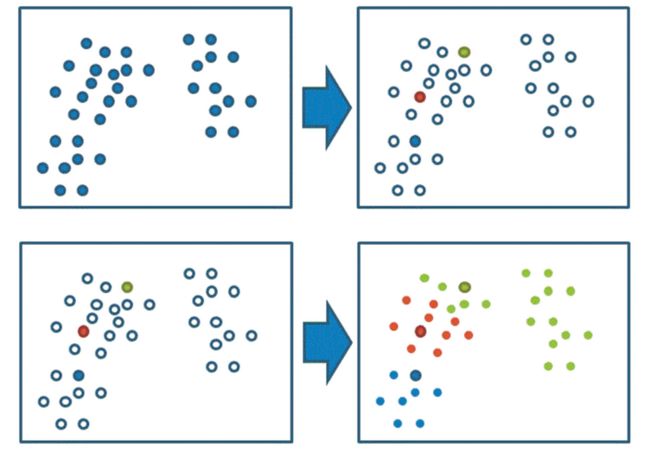

k聚类动态效果图
案例练习

1、随机设置K个特征空间内的点作为初始的聚类中心(本案例中设置p1和p2)
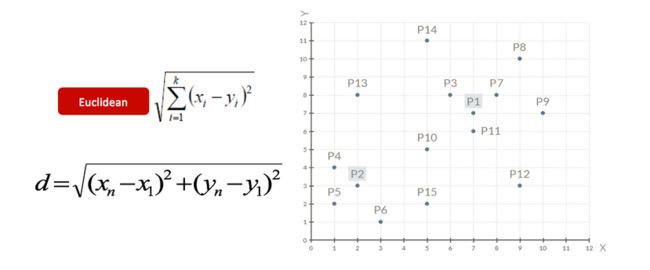
2、对于其他每个点计算到K个中心的距离,未知的点选择最近的一个聚类中心点作为标记类别

3、接着对着标记的聚类中心之后,重新计算出每个聚类的新中心点(平均值)

4、如果计算得出的新中心点与原中心点一样(质心不再移动),那么结束,否则重新进行第二步过程【经过判断,需要重复上述步骤,开始新一轮迭代】
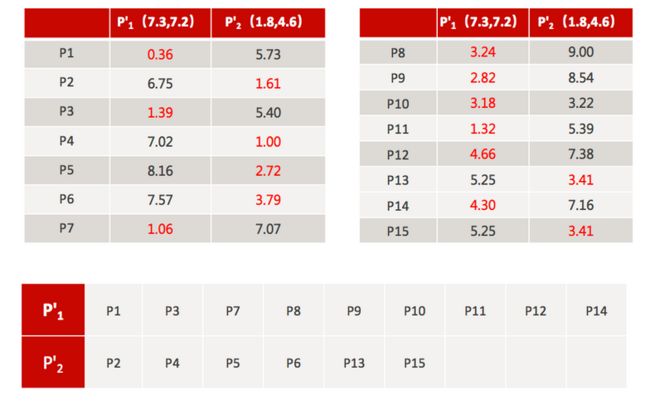
5、当每次迭代结果不变时,认为算法收敛,聚类完成,K-Means一定会停下,不可能陷入一直选质心的过程。
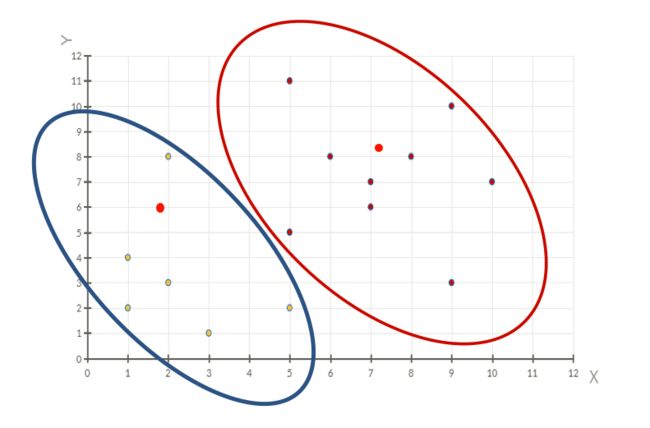
小结
流程:
- 事先确定常数K,常数K意味着最终的聚类类别数;
- 首先随机选定初始点为质心,并通过计算每一个样本与质心之间的相似度(这里为欧式距离),将样本点归到最相似的类中,
- 接着,重新计算每个类的质心(即为类中心),重复这样的过程,直到质心不再改变,
- 最终就确定了每个样本所属的类别以及每个类的质心。
注意:
由于每次都要计算所有的样本与每一个质心之间的相似度,故在大规模的数据集上,K-Means算法的收敛速度比较慢
api介绍
sklearn.cluster.KMeans(n_clusters=8)
参数:
n_clusters:开始的聚类中心数量
整型,缺省值=8,生成的聚类数,即产生的质心(centroids)数。
方法:
estimator.fit(x)
estimator.predict(x)
estimator.fit_predict(x)
计算聚类中心并预测每个样本属于哪个类别,相当于先调用fit(x),然后再调用predict(x)
案例实战
import matplotlib.pyplot as plt
from sklearn.cluster import KMeans
from sklearn.datasets import make_blobs
#用calinski_harabaz_score方法评价聚类效果的好坏大概是类间距除以类内距,因此这个值越大越好
from sklearn.metrics import calinski_harabasz_score
# 创建数据
X, y = make_blobs(n_samples=1000, n_features=2, centers=[
[-1, -1], [0, 0], [1, 1], [2, 2]], cluster_std=[0.4, 0.2, 0.2, 0.2], random_state=9)
X.shape, y.shape
((1000, 2), (1000,))
plt.scatter(X[:, 0], X[:, 1])
plt.show()
# kmeans训练,且可视化 聚类=2
y_predict = KMeans(n_clusters=2, random_state=9).fit_predict(X)
print(y_predict[:10])
plt.scatter(X[:, 0], X[:, 1], c=y_predict)
plt.show()
print(calinski_harabasz_score(X, y_predict))
# kmeans训练,且可视化 聚类=3
y_predict = KMeans(n_clusters=3, random_state=9).fit_predict(X)
print(y_predict[:10])
plt.scatter(X[:, 0], X[:, 1], c=y_predict)
plt.show()
print(calinski_harabasz_score(X, y_predict))
# kmeans训练,且可视化 聚类=4
y_predict = KMeans(n_clusters=4, random_state=9).fit_predict(X)
print(y_predict[:10])
plt.scatter(X[:, 0], X[:, 1], c=y_predict)
plt.show()
print(calinski_harabasz_score(X, y_predict))
案例: 探究用户对物品类别的喜好细分
地址: https://www.kaggle.com/c/instacart-market-basket-analysis/data
 数据如下:
数据如下:
- order_products__prior.csv:订单与商品信息
字段:order_id, product_id, add_to_cart_order, reordered - products.csv:商品信息
字段:product_id, product_name, aisle_id, department_id - orders.csv:用户的订单信息
字段:order_id,user_id,eval_set,order_number,…. - aisles.csv:商品所属具体物品类别
字段: aisle_id, aisle
1.获取数据
import pandas as pd
from sklearn.decomposition import PCA
from sklearn.cluster import KMeans
## 轮廓系数取值为[-1, 1],其值越大越好,且当值为负时,
# 表明样本被分配到错误的簇中,聚类结果不可接受。对于接近0的结果,则表明聚类结果有重叠的情况
from sklearn.metrics import silhouette_score
# 1.获取数据
order_product = pd.read_csv("./data/instacart/order_products__prior.csv")
products = pd.read_csv("./data/instacart/products.csv")
orders = pd.read_csv("./data/instacart/orders.csv")
aisles = pd.read_csv("./data/instacart/aisles.csv")
order_product.head()
| order_id | product_id | add_to_cart_order | reordered | |
|---|---|---|---|---|
| 0 | 2 | 33120 | 1 | 1 |
| 1 | 2 | 28985 | 2 | 1 |
| 2 | 2 | 9327 | 3 | 0 |
| 3 | 2 | 45918 | 4 | 1 |
| 4 | 2 | 30035 | 5 | 0 |
products.head()
| product_id | product_name | aisle_id | department_id | |
|---|---|---|---|---|
| 0 | 1 | Chocolate Sandwich Cookies | 61 | 19 |
| 1 | 2 | All-Seasons Salt | 104 | 13 |
| 2 | 3 | Robust Golden Unsweetened Oolong Tea | 94 | 7 |
| 3 | 4 | Smart Ones Classic Favorites Mini Rigatoni Wit... | 38 | 1 |
| 4 | 5 | Green Chile Anytime Sauce | 5 | 13 |
orders.head()
| order_id | user_id | eval_set | order_number | order_dow | order_hour_of_day | days_since_prior_order | |
|---|---|---|---|---|---|---|---|
| 0 | 2539329 | 1 | prior | 1 | 2 | 8 | NaN |
| 1 | 2398795 | 1 | prior | 2 | 3 | 7 | 15.0 |
| 2 | 473747 | 1 | prior | 3 | 3 | 12 | 21.0 |
| 3 | 2254736 | 1 | prior | 4 | 4 | 7 | 29.0 |
| 4 | 431534 | 1 | prior | 5 | 4 | 15 | 28.0 |
aisles.head()
| aisle_id | aisle | |
|---|---|---|
| 0 | 1 | prepared soups salads |
| 1 | 2 | specialty cheeses |
| 2 | 3 | energy granola bars |
| 3 | 4 | instant foods |
| 4 | 5 | marinades meat preparation |
2.数据基本处理
# 合并表格
table1 = pd.merge(order_product, products, on=["product_id", "product_id"])
table2 = pd.merge(table1, orders, on=["order_id", "order_id"])
table = pd.merge(table2, aisles, on=["aisle_id", "aisle_id"])
print(table.shape)
(32434489, 14)
table.head()
| order_id | product_id | add_to_cart_order | reordered | product_name | aisle_id | department_id | user_id | eval_set | order_number | order_dow | order_hour_of_day | days_since_prior_order | aisle | |
|---|---|---|---|---|---|---|---|---|---|---|---|---|---|---|
| 0 | 2 | 33120 | 1 | 1 | Organic Egg Whites | 86 | 16 | 202279 | prior | 3 | 5 | 9 | 8.0 | eggs |
| 1 | 26 | 33120 | 5 | 0 | Organic Egg Whites | 86 | 16 | 153404 | prior | 2 | 0 | 16 | 7.0 | eggs |
| 2 | 120 | 33120 | 13 | 0 | Organic Egg Whites | 86 | 16 | 23750 | prior | 11 | 6 | 8 | 10.0 | eggs |
| 3 | 327 | 33120 | 5 | 1 | Organic Egg Whites | 86 | 16 | 58707 | prior | 21 | 6 | 9 | 8.0 | eggs |
| 4 | 390 | 33120 | 28 | 1 | Organic Egg Whites | 86 | 16 | 166654 | prior | 48 | 0 | 12 | 9.0 | eggs |
# 交叉表合并 table["user_id"]为行索引, table["aisle"]为列索引
data = pd.crosstab(table["user_id"], table["aisle"])
data.head()
| aisle | air fresheners candles | asian foods | baby accessories | baby bath body care | baby food formula | bakery desserts | baking ingredients | baking supplies decor | beauty | beers coolers | ... | spreads | tea | tofu meat alternatives | tortillas flat bread | trail mix snack mix | trash bags liners | vitamins supplements | water seltzer sparkling water | white wines | yogurt |
|---|---|---|---|---|---|---|---|---|---|---|---|---|---|---|---|---|---|---|---|---|---|
| user_id | |||||||||||||||||||||
| 1 | 0 | 0 | 0 | 0 | 0 | 0 | 0 | 0 | 0 | 0 | ... | 1 | 0 | 0 | 0 | 0 | 0 | 0 | 0 | 0 | 1 |
| 2 | 0 | 3 | 0 | 0 | 0 | 0 | 2 | 0 | 0 | 0 | ... | 3 | 1 | 1 | 0 | 0 | 0 | 0 | 2 | 0 | 42 |
| 3 | 0 | 0 | 0 | 0 | 0 | 0 | 0 | 0 | 0 | 0 | ... | 4 | 1 | 0 | 0 | 0 | 0 | 0 | 2 | 0 | 0 |
| 4 | 0 | 0 | 0 | 0 | 0 | 0 | 0 | 0 | 0 | 0 | ... | 0 | 0 | 0 | 1 | 0 | 0 | 0 | 1 | 0 | 0 |
| 5 | 0 | 2 | 0 | 0 | 0 | 0 | 0 | 0 | 0 | 0 | ... | 0 | 0 | 0 | 0 | 0 | 0 | 0 | 0 | 0 | 3 |
5 rows × 134 columns
data.shape
(206209, 134)
# 数据截取
new_data = data[:1000]
# 3.特征工程 — pca
transfer = PCA(0.9)
trans_data = transfer.fit_transform(new_data)
trans_data.shape
(1000, 22)
# 4.机器学习(k-means)
estimator = KMeans(n_clusters=5)
y_pred = estimator.fit_predict(trans_data)
print(y_pred[:20])
# 5.模型评估
print(silhouette_score(trans_data, y_pred))
[3 0 3 3 3 3 0 3 3 0 3 3 3 3 3 3 3 3 3 3]
0.4585956252548508
2D数据类别划分
任务:
1、采用Kmeans算法实现2D数据自动聚类,预测V1=80,V2=60数据类别;
2、计算预测准确率,完成结果矫正
3、采用KNN、Meanshift算法,重复步骤1-2
Mean Shift算法,一般是指一个迭代的步骤,即先算出当前点的偏移均值,移动该点到其偏移均值,然后以此为新的起始点,继续移动,直到满足一定的条件结束
数据:data.csv
#load the data
import pandas as pd
import numpy as np
data = pd.read_csv('data.csv')
data.head()
| V1 | V2 | labels | |
|---|---|---|---|
| 0 | 2.072345 | -3.241693 | 0 |
| 1 | 17.936710 | 15.784810 | 0 |
| 2 | 1.083576 | 7.319176 | 0 |
| 3 | 11.120670 | 14.406780 | 0 |
| 4 | 23.711550 | 2.557729 | 0 |
#define X and y
X = data.drop(['labels'],axis=1)
y = data.loc[:,'labels']
y.head()
0 0
1 0
2 0
3 0
4 0
Name: labels, dtype: int64
pd.value_counts(y)
2 1156
1 954
0 890
Name: labels, dtype: int64
%matplotlib inline
from matplotlib import pyplot as plt
fig1 = plt.figure()
plt.scatter(X.loc[:,'V1'],X.loc[:,'V2'])
plt.title("un-labled data")
plt.xlabel('V1')
plt.ylabel('V2')
plt.show()
fig1 = plt.figure()
label0 = plt.scatter(X.loc[:,'V1'][y==0],X.loc[:,'V2'][y==0])
label1 = plt.scatter(X.loc[:,'V1'][y==1],X.loc[:,'V2'][y==1])
label2 = plt.scatter(X.loc[:,'V1'][y==2],X.loc[:,'V2'][y==2])
plt.title("labled data")
plt.xlabel('V1')
plt.ylabel('V2'))
plt.legend((label0,label1,label2),('label0','label1','label2'))
plt.show()
print(X.shape,y.shape)
(3000, 2) (3000,)
from sklearn.cluster import KMeans
KM = KMeans(n_clusters=3, random_state=0)
KM.fit(X)
KMeans(n_clusters=3, random_state=0)
centers = KM.cluster_centers_
centers # 3个中心坐标
array([[ 69.92418447, -10.11964119],
[ 40.68362784, 59.71589274],
[ 9.4780459 , 10.686052 ]])
fig1 = plt.figure()
label0 = plt.scatter(X.loc[:,'V1'][y==0],X.loc[:,'V2'][y==0])
label1 = plt.scatter(X.loc[:,'V1'][y==1],X.loc[:,'V2'][y==1])
label2 = plt.scatter(X.loc[:,'V1'][y==2],X.loc[:,'V2'][y==2])
plt.title("labled data")
plt.xlabel('V1')
plt.ylabel('V2')
# 画中心点
plt.scatter(centers[:, 0], centers[:, 1])
plt.legend((label0,label1,label2),('label0','label1','label2'))
plt.show()
# 预测V1=80,V2=60数据类别;
y_predict = KM.predict(np.array([[80, 60]]))
y_predict
array([1], dtype=int32)
y_predict = KM.predict(X)
print(pd.value_counts(y_predict))
1 1149
0 952
2 899
dtype: int64
pd.value_counts(y)
2 1156
1 954
0 890
Name: labels, dtype: int64
from sklearn.metrics import accuracy_score
accuracy_score(y, y_predict)
0.0023333333333333335
#visualize the data and results
fig4 = plt.subplot(121)
label0 = plt.scatter(X.loc[:,'V1'][y_predict==0],X.loc[:,'V2'][y_predict==0])
label1 = plt.scatter(X.loc[:,'V1'][y_predict==1],X.loc[:,'V2'][y_predict==1])
label2 = plt.scatter(X.loc[:,'V1'][y_predict==2],X.loc[:,'V2'][y_predict==2])
plt.title("predicted data")
plt.xlabel('V1')
plt.ylabel('V2')
plt.legend((label0,label1,label2),('label0','label1','label2'))
plt.scatter(centers[:,0],centers[:,1])
fig5 = plt.subplot(122)
label0 = plt.scatter(X.loc[:,'V1'][y==0],X.loc[:,'V2'][y==0])
label1 = plt.scatter(X.loc[:,'V1'][y==1],X.loc[:,'V2'][y==1])
label2 = plt.scatter(X.loc[:,'V1'][y==2],X.loc[:,'V2'][y==2])
plt.title("labled data")
plt.xlabel('V1')
plt.ylabel('V2')
plt.legend((label0,label1,label2),('label0','label1','label2'))
plt.scatter(centers[:,0],centers[:,1])
plt.show()
#correct the results
y_corrected = []
for i in y_predict:
if i == 0:
y_corrected.append(1)
elif i == 1:
y_corrected.append(2)
else:
y_corrected.append(0)
y_corrected = np.array(y_corrected)
accuracy_score(y, y_corrected)
0.997
#visualize the data and results
fig4 = plt.subplot(121)
label0 = plt.scatter(X.loc[:,'V1'][y_corrected==0],X.loc[:,'V2'][y_corrected==0])
label1 = plt.scatter(X.loc[:,'V1'][y_corrected==1],X.loc[:,'V2'][y_corrected==1])
label2 = plt.scatter(X.loc[:,'V1'][y_corrected==2],X.loc[:,'V2'][y_corrected==2])
plt.title("predicted data")
plt.xlabel('V1')
plt.ylabel('V2')
plt.legend((label0,label1,label2),('label0','label1','label2'))
plt.scatter(centers[:,0],centers[:,1])
fig5 = plt.subplot(122)
label0 = plt.scatter(X.loc[:,'V1'][y==0],X.loc[:,'V2'][y==0])
label1 = plt.scatter(X.loc[:,'V1'][y==1],X.loc[:,'V2'][y==1])
label2 = plt.scatter(X.loc[:,'V1'][y==2],X.loc[:,'V2'][y==2])
plt.title("labled data")
plt.xlabel('V1')
plt.ylabel('V2')
plt.legend((label0,label1,label2),('label0','label1','label2'))
plt.scatter(centers[:,0],centers[:,1])
plt.show()
注意和KNN 的区别
from sklearn.neighbors import KNeighborsClassifier
KNN = KNeighborsClassifier(n_neighbors=3)
KNN.fit(X,y)
KNeighborsClassifier(n_neighbors=3)
#predict based on the test data V1=80, V2=60
y_predict_knn_test = KNN.predict([[80,60]])
y_predict_knn = KNN.predict(X)
print(y_predict_knn_test)
print('knn accuracy:',accuracy_score(y,y_predict_knn))
[2]
knn accuracy: 1.0
print(pd.value_counts(y_predict_knn),pd.value_counts(y))
2 1156
1 954
0 890
dtype: int64 2 1156
1 954
0 890
Name: labels, dtype: int64
fig6 = plt.subplot(121)
label0 = plt.scatter(X.loc[:,'V1'][y_predict_knn==0],X.loc[:,'V2'][y_predict_knn==0])
label1 = plt.scatter(X.loc[:,'V1'][y_predict_knn==1],X.loc[:,'V2'][y_predict_knn==1])
label2 = plt.scatter(X.loc[:,'V1'][y_predict_knn==2],X.loc[:,'V2'][y_predict_knn==2])
plt.title("knn results")
plt.xlabel('V1')
plt.ylabel('V2')
plt.legend((label0,label1,label2),('label0','label1','label2'))
plt.scatter(centers[:,0],centers[:,1])
fig7 = plt.subplot(122)
label0 = plt.scatter(X.loc[:,'V1'][y==0],X.loc[:,'V2'][y==0])
label1 = plt.scatter(X.loc[:,'V1'][y==1],X.loc[:,'V2'][y==1])
label2 = plt.scatter(X.loc[:,'V1'][y==2],X.loc[:,'V2'][y==2])
plt.title("labled data")
plt.xlabel('V1')
plt.ylabel('V2')
plt.legend((label0,label1,label2),('label0','label1','label2'))
plt.scatter(centers[:,0],centers[:,1])
plt.show()
meanshift
from sklearn.cluster import MeanShift,estimate_bandwidth
# 预估带宽
bw = estimate_bandwidth(X,n_samples=500)
#establish the meanshift model-un-supervised model
ms = MeanShift(bandwidth=bw)
ms.fit(X)
MeanShift(bandwidth=30.84663454820215)
y_predict_ms = ms.predict(X)
print(pd.value_counts(y_predict_ms),pd.value_counts(y))
0 1149
1 952
2 899
dtype: int64 2 1156
1 954
0 890
Name: labels, dtype: int64
#新增代码 打印使用meanshift算法获取的聚类中心 与kmeans算法对比 中心点非常接近
centers2 = ms.cluster_centers_
print(centers2)#meanshift聚类中心
[[ 40.60158864 59.65137971]
[ 70.01854306 -10.11803404]
[ 9.56752568 10.79316266]]
centers
array([[ 69.92418447, -10.11964119],
[ 40.68362784, 59.71589274],
[ 9.4780459 , 10.686052 ]])
fig6 = plt.subplot(121)
label0 = plt.scatter(X.loc[:,'V1'][y_predict_ms==0],X.loc[:,'V2'][y_predict_ms==0])
label1 = plt.scatter(X.loc[:,'V1'][y_predict_ms==1],X.loc[:,'V2'][y_predict_ms==1])
label2 = plt.scatter(X.loc[:,'V1'][y_predict_ms==2],X.loc[:,'V2'][y_predict_ms==2])
plt.title("ms results")
plt.xlabel('V1')
plt.ylabel('V2')
plt.legend((label0,label1,label2),('label0','label1','label2'))
plt.scatter(centers[:,0],centers[:,1])
fig7 = plt.subplot(122)
label0 = plt.scatter(X.loc[:,'V1'][y==0],X.loc[:,'V2'][y==0])
label1 = plt.scatter(X.loc[:,'V1'][y==1],X.loc[:,'V2'][y==1])
label2 = plt.scatter(X.loc[:,'V1'][y==2],X.loc[:,'V2'][y==2])
plt.title("labled data")
plt.xlabel('V1')
plt.ylabel('V2')
plt.legend((label0,label1,label2),('label0','label1','label2'))
plt.scatter(centers[:,0],centers[:,1])
plt.show()
#correct the results
y_corrected_ms = []
for i in y_predict_ms:
if i==0:
y_corrected_ms.append(2)
elif i==1:
y_corrected_ms.append(1)
else:
y_corrected_ms.append(0)
y_corrected_ms = np.array(y_corrected_ms)
print(type(y_corrected_ms))
print(pd.value_counts(y_corrected_ms),pd.value_counts(y))
2 1149
1 952
0 899
dtype: int64 2 1156
1 954
0 890
Name: labels, dtype: int64
fig6 = plt.subplot(121)
label0 = plt.scatter(X.loc[:,'V1'][y_corrected_ms==0],X.loc[:,'V2'][y_corrected_ms==0])
label1 = plt.scatter(X.loc[:,'V1'][y_corrected_ms==1],X.loc[:,'V2'][y_corrected_ms==1])
label2 = plt.scatter(X.loc[:,'V1'][y_corrected_ms==2],X.loc[:,'V2'][y_corrected_ms==2])
plt.title("ms corrected results")
plt.xlabel('V1')
plt.ylabel('V2')
plt.legend((label0,label1,label2),('label0','label1','label2'))
plt.scatter(centers[:,0],centers[:,1])
fig7 = plt.subplot(122)
label0 = plt.scatter(X.loc[:,'V1'][y==0],X.loc[:,'V2'][y==0])
label1 = plt.scatter(X.loc[:,'V1'][y==1],X.loc[:,'V2'][y==1])
label2 = plt.scatter(X.loc[:,'V1'][y==2],X.loc[:,'V2'][y==2])
plt.title("labled data")
plt.xlabel('V1')
plt.ylabel('V2')
plt.legend((label0,label1,label2),('label0','label1','label2'))
plt.scatter(centers[:,0],centers[:,1])
plt.show()
Meanshift
一般是指一个迭代的步骤,即先算出当前点的偏移均值,移动该点到其偏移均值,然后以此为新的起始点,继续移动,直到满足一定的条件结束.

Sk是一个半径为h的高维球区域,满足以下关系的y点的集合,
![]()
k表示在这n个样本点xi中,有k个点落入Sk区域中.
以上是官方的说法,在d维空间中,任选一个点,然后以这个点为圆心,h为半径做一个高维球,因为有d维,d可能大于2,所以是高维球。落在这个球内的所有点和圆心都会产生一个向量,向量是以圆心为起点落在球内的点位终点。然后把这些向量都相加。相加的结果就是Meanshift向量。

再以meanshift向量的终点为圆心,再做一个高维的球。如下图所以,重复以上步骤,就可得到一个meanshift向量。如此重复下去,meanshift算法可以收敛到概率密度最大得地方。也就是最稠密的地方。

mean shift 聚类流程:
假设在一个多维空间中有很多数据点需要进行聚类,Mean Shift的过程如下:
- 在未被标记的数据点中随机选择一个点作为中心center;
- 找出离center距离在bandwidth之内的所有点,记做集合M,认为这些点属于簇c。同时,把这些球内点属于这个类的概率加1,这个参数将用于最后步骤的分类
- 以center为中心点,计算从center开始到集合M中每个元素的向量,将这些向量相加,得到向量shift。
- center = center+shift。即center沿着shift的方向移动,移动距离是||shift||。
- 重复步骤2、3、4,直到shift的大小很小(就是迭代到收敛),记住此时的center。注意,这个迭代过程中遇到的点都应该归类到簇c。
- 如果收敛时当前簇c的center与其它已经存在的簇c2中心的距离小于阈值,那么把c2和c合并。否则,把c作为新的聚类,增加1类。 重复1、2、3、4、5直到所有的点都被标记访问。
- 分类:根据每个类,对每个点的访问频率,取访问频率最大的那个类,作为当前点集的所属类。 简单的说,mean shift就是沿着密度上升的方向寻找同属一个簇的数据点。

使用MeanShift
from sklearn.cluster import MeanShift, estimate_bandwidth
bw = estimate_bandwidth(X, n_samples=500)
print('bw = ', bw)
ms = MeanShift(bandwidth=bw)
ms.fit(X)
y_predict_ms = ms.predict(X)
centers = ms.cluster_centers_
print(centers)
fig1 = plt.subplot(121)
label0 = plt.scatter(X.loc[:, 'V1'][y_predict_ms==0], X.loc[:, 'V2'][y_predict_ms==0], color='b' )
label1 = plt.scatter(X.loc[:, 'V1'][y_predict_ms==1], X.loc[:, 'V2'][y_predict_ms==1], color='g')
label2 = plt.scatter(X.loc[:, 'V1'][y_predict_ms==2], X.loc[:, 'V2'][y_predict_ms==2], color='r')
plt.title("预测数据分布")
plt.xlabel('v1')
plt.ylabel('v2')
plt.legend((label0,label1,label2), ('标签1', '标签2','标签3'))
plt.scatter(centers[:, 0], centers[:, 1])
plt.subplot(122)
label0 = plt.scatter(X.loc[:, 'V1'][y==0], X.loc[:, 'V2'][y==0], color='b' )
label1 = plt.scatter(X.loc[:, 'V1'][y==1], X.loc[:, 'V2'][y==1], color='g')
label2 = plt.scatter(X.loc[:, 'V1'][y==2], X.loc[:, 'V2'][y==2], color='r')
plt.title("真实数据分布")
plt.xlabel('v1')
plt.ylabel('v2')
plt.legend((label0,label1,label2), ('标签1', '标签2','标签3'))
plt.scatter(centers[:, 0], centers[:, 1])
plt.show()
#correct the results
y_corrected_ms = []
for i in y_predict_ms:
if i==0:
y_corrected_ms.append(2)
elif i==1:
y_corrected_ms.append(1)
else:
y_corrected_ms.append(0)
print(pd.value_counts(y_corrected_ms),pd.value_counts(y))
y_predict = np.array(y_corrected_ms)
fig1 = plt.subplot(121)
label0 = plt.scatter(X.loc[:, 'V1'][y_predict==0], X.loc[:, 'V2'][y_predict==0], color='b' )
label1 = plt.scatter(X.loc[:, 'V1'][y_predict==1], X.loc[:, 'V2'][y_predict==1], color='g')
label2 = plt.scatter(X.loc[:, 'V1'][y_predict==2], X.loc[:, 'V2'][y_predict==2], color='r')
plt.title("预测数据分布")
plt.xlabel('v1')
plt.ylabel('v2')
plt.legend((label0,label1,label2), ('标签1', '标签2','标签3'))
plt.scatter(centers[:, 0], centers[:, 1])
plt.subplot(122)
label0 = plt.scatter(X.loc[:, 'V1'][y==0], X.loc[:, 'V2'][y==0], color='b' )
label1 = plt.scatter(X.loc[:, 'V1'][y==1], X.loc[:, 'V2'][y==1], color='g')
label2 = plt.scatter(X.loc[:, 'V1'][y==2], X.loc[:, 'V2'][y==2], color='r')
plt.title("真实数据分布")
plt.xlabel('v1')
plt.ylabel('v2')
plt.legend((label0,label1,label2), ('标签1', '标签2','标签3'))
plt.scatter(centers[:, 0], centers[:, 1])
plt.show()
实现
import random
from sklearn import datasets
import numpy as np
import matplotlib.pyplot as plt
from mpl_toolkits.mplot3d import Axes3D
class Kmeans():
"""Kmeans聚类算法.
Parameters:
-----------
k: int
聚类的数目.
max_iterations: int
最大迭代次数.
varepsilon: float
判断是否收敛, 如果上一次的所有k个聚类中心与本次的所有k个聚类中心的差都小于varepsilon,
则说明算法已经收敛
"""
def __init__(self, k=2, max_iterations=500, varepsilon=1e-4):
self.k = k
self.max_iterations = max_iterations
self.varepsilon = varepsilon
# 从所有样本中随机选取self.k样本作为初始的聚类中心
def init_random_centroids(self, X):
n_samples, n_features = np.shape(X)
centroids = np.zeros((self.k, n_features))
for i in range(self.k):
centroid = X[np.random.choice(range(n_samples))]
centroids[i] = centroid
return centroids
# 返回距离该样本最近的一个中心索引[0, self.k)
def _closest_centroid(self, sample, centroids):
distances = self.euclidean_distance(sample, centroids)
closest_i = np.argmin(distances)
return closest_i
# 将所有样本进行归类,归类规则就是将该样本归类到与其最近的中心
def create_clusters(self, centroids, X):
n_samples = np.shape(X)[0]
clusters = [[] for _ in range(self.k)]
for sample_i, sample in enumerate(X):
centroid_i = self._closest_centroid(sample, centroids)
clusters[centroid_i].append(sample_i)
return clusters
# 对中心进行更新
def update_centroids(self, clusters, X):
n_features = np.shape(X)[1]
centroids = np.zeros((self.k, n_features))
for i, cluster in enumerate(clusters):
centroid = np.mean(X[cluster], axis=0)
centroids[i] = centroid
return centroids
# 将所有样本进行归类,其所在的类别的索引就是其类别标签
def get_cluster_labels(self, clusters, X):
y_pred = np.zeros(np.shape(X)[0])
for cluster_i, cluster in enumerate(clusters):
for sample_i in cluster:
y_pred[sample_i] = cluster_i
return y_pred
# 计算一个样本与数据集中所有样本的欧氏距离的平方
def euclidean_distance(self, one_sample, X):
one_sample = one_sample.reshape(1, -1)
X = X.reshape(X.shape[0], -1)
distances = np.power(np.tile(one_sample, (X.shape[0], 1)) - X, 2).sum(axis=1)
return distances
# 对整个数据集X进行Kmeans聚类,返回其聚类的标签
def predict(self, X):
# 从所有样本中随机选取self.k样本作为初始的聚类中心
centroids = self.init_random_centroids(X)
# 迭代,直到算法收敛(上一次的聚类中心和这一次的聚类中心几乎重合)或者达到最大迭代次数
for _ in range(self.max_iterations):
# 将所有进行归类,归类规则就是将该样本归类到与其最近的中心
clusters = self.create_clusters(centroids, X)
former_centroids = centroids
# 计算新的聚类中心
centroids = self.update_centroids(clusters, X)
# 如果聚类中心几乎没有变化,说明算法已经收敛,退出迭代
diff = centroids - former_centroids
if diff.any() < self.varepsilon:
break
return self.get_cluster_labels(clusters, X)
def main():
# Load the dataset
X, y = datasets.make_blobs(n_samples=10000,
n_features=3,
centers=[[3,3, 3], [0,0,0], [1,1,1], [2,2,2]],
cluster_std=[0.2, 0.1, 0.2, 0.2],
random_state =9)
# 用Kmeans算法进行聚类
clf = Kmeans(k=4)
y_pred = clf.predict(X)
print(y_pred)
# 可视化聚类效果
# fig = plt.figure(figsize=(12, 8))
# ax = Axes3D(fig, rect=[0, 0, 1, 1], elev=30, azim=20)
# plt.scatter(X[y==0][:, 0], X[y==0][:, 1], X[y==0][:, 2])
# plt.scatter(X[y==1][:, 0], X[y==1][:, 1], X[y==1][:, 2])
# plt.scatter(X[y==2][:, 0], X[y==2][:, 1], X[y==2][:, 2])
# plt.scatter(X[y==3][:, 0], X[y==3][:, 1], X[y==3][:, 2])
# plt.show()
fig = plt.figure(figsize=(12, 8))
ax = Axes3D(fig)
plt.scatter(X[y_pred==0][:, 0], X[y_pred==0][:, 1], X[y_pred==0][:, 2], label='y==0', color='b')
plt.scatter(X[y_pred==1][:, 0], X[y_pred==1][:, 1], X[y_pred==1][:, 2], label='y==1', color='r')
plt.scatter(X[y_pred==2][:, 0], X[y_pred==2][:, 1], X[y_pred==2][:, 2], label='y==2', color='g')
plt.scatter(X[y_pred==3][:, 0], X[y_pred==3][:, 1], X[y_pred==3][:, 2], label='y==3', color='purple')
plt.legend()
plt.show()
if __name__ == "__main__":
main()
实验结果
